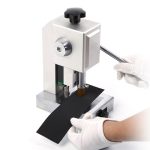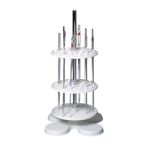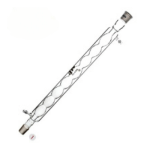
How to Install the Cutting Die of Coin Cell Disc Cutter AOT-CP60
When working with coin cell disc cutters like the AOT-CP60, proper installation of the cutting die is crucial for achieving
Empowering researchers with innovative and reliable scientific equipment to drive progress and innovation globally.
To provide high-quality, innovative, and reliable scientific equipment and instruments to enable researchers, scientists, and professionals to achieve their goals and make impactful discoveries that advance knowledge and improve lives.
Our vision is to be the leading provider of cutting-edge scientific equipment and instruments, known for our commitment to excellence, customer satisfaction, and driving progress in research and innovation globally.







































Our team of skilled technicians ensures the precise and efficient installation of all our scientific equipment. We provide comprehensive setup services to guarantee your instruments are operational and ready for immediate use.
We offer reliable repair and maintenance services to keep your equipment in optimal condition. Our experts are dedicated to providing timely support, ensuring minimal downtime and prolonged lifespan for your instruments.
Have questions? Find answers to the most common inquiries here.
What is the main benefit of heating during the calendaring?
Electric Type roller press Machine:

Heated Type Roller Press Machine:

1. The heated type equipped with transparent protective plate for safer use.
2. The heated roller press can improve the pressing efficiency, save the calendering time.
3. The heat press have a better performance than cold press in thinning and increasing density of lithium battery electrode.
We suggest you to choose the most suitable type accordingly, if the heating function is not necessary, then electric type is the best choice.

For the screw that you showed in the picture, it is using for taking out the cases when it is stucked during the crimping process.
Clockwise rotation and you can take cases out, and then contrarotate the screw back to the previous position.
Note: it is useless when you doing normal operation.

Different dies for cutting electrode and battery separator:

Step 1: Install upper die, and fasten it with screw.

Step 2: Take off the rubber which is on the upper die.

Step 3: Match the upper die and lower die, make them closed in a good condition.

Step 4: Press the handle and hold on, make sure the holes are aligned.

Step 5: Fit and fasten the screws by the wrench, and then loosen the handle.

Step 6: Put on the rubber, then you can start cutting battery electrode

As we all know, the lithium ion battery is widely use in industry and our daily life, like your cell phone, laptop, new energy vehicle and so on.
But do you know what are the main materials of lithium ion battery? How does a battery made of? Here we are glad to introduce the materials which are used in a lithium ion battery.

1. Cathode material: Lithium Iron Phosphate (LiFePO4/LFP); Lithium Nickel Manganese Cobalt Oxide (LiNiMnCoO2 powder, include NMC811,NCM622,NMC 532,NMC111); Lithium Cobalt Oxide (LCO); Lithium Manganese Oxide (LMO); Organic solvent Methyl-2-pyrrolidinone (NMP); Binder polyvinylidene fluoride (PVDF); Alumium foil etc.
2. Anode material: Battery Graphite (include artificial type and natural type);Mesophase Carbon Micro Beads (MCMB); Lithium Titanate powder (LTO); Solvent Styrene Butadiene Rubber (SBR); Organic Polymer Carboxymethyl Cellulose (CMC); Petroleum Coke; Carbon Fiber; Pyrolytic Resin Carbon, Polytetrafluoroethylene (PTFE); Copper foil etc.
3. Other material: Battery electrolyte, such as LiPF6; Battery separator, PP and PE membrane; Lithium Metal Chips/Foil/Ingot; Hard Carbon (Irregular type and spherical type); Aluminum laminated film for pouch cell cases making; Nickel Strip/foil; Teflon tape; High temperature tape; Battery Strapping Tape for pouch cell etc.
In the use of lithium batteries, it should be noted that after the battery is placed for a period of time, it enters a sleep state. At this time, the capacity is lower than the normal value, and the use time is also shortened. However, the lithium battery is easy to activate, as long as the normal charge and discharge cycle is 3-5 times, the battery can be activated to restore normal capacity. Due to the characteristics of the lithium battery itself, it is determined that it has almost no memory effect. Therefore, the new lithium battery in the user’s mobile phone does not require special methods and equipment during the activation process.
The correct way to charge lithium batteries:
To sum up, my most important tips on the charge and discharge of lithium batteries in use are:
1. Charge according to standard time and procedures, even if it is the first three times;
2. When the power is too low, you should start charging as soon as possible;
3. The activation of the lithium battery does not require a special method, and the lithium battery will naturally activate during normal use. If you insist on using the “first three 12-hour long charge activation” method that is circulated, it will not actually work.
Therefore, all the pursuit of 12 to 16 hours of ultra-long charging and the use of lithium batteries to automatically shut down are wrong.
1. No memory effect
2. Large capacity (high energy density)
3. Long cycle life (300-2000)
4. No pollution
5. Low self-discharge rate
6. High voltage platform
7. High and low temperature adaptation Strong
8. Other characteristics.
The lithium battery utilizes lithium ions stored in the positive electrode material and electrons to reversely move during charging and discharging to achieve normal operation. The main structures are a positive electrode, a negative electrode and an electrolyte. In addition to the main four parts, the current collector for storing the positive and negative materials is also an important component of the lithium battery. Its main function is to collect the current generated by the battery active material to form a larger current for external output.
According to the working principle and structural design of the lithium ion battery, the positive and negative materials should be coated on the conductive current collector, so the current collector should be in full contact with the active material, and the internal resistance should be as small as possible.

Copper foil and Aluminum Foil have good conductivity, have formed oxidized protective film, soft texture is favorable for bonding, mature manufacturing technology and relatively low price, so they are selected as the main material of lithium battery current collector.
The positive electrode potential of the lithium battery is high, the oxide layer of the aluminum foil is relatively dense, and the current collector can be prevented from being oxidized, and the lithium intercalation reaction occurs at a high potential, the copper foil is not suitable for positive current collector , so the positive current collector is generally made of aluminum foil.

The potential of the negative electrode is low, the aluminum foil is easy to form an aluminum-lithium alloy at a low potential, and the negative electrode current collector is generally made of copper foil, and the copper foil and the aluminum foil do not have interchangeability.
Advantages:
1. The energy is relatively high. With high storage energy density, it has reached 460-600Wh/kg, which is about 6-7 times that of lead-acid batteries;
2. It has a long service life and can last for more than 6 years. Lithium iron phosphate (LFP) battery with 1C (100%DOD) charge and discharge, it can be used for 10,000 times;
3. High rated voltage (single working voltage is 3.7V or 3.2V), which is equal to the series voltage of 3 nickel-cadmium or nickel-metal hydride rechargeable batteries, which is convenient for battery power packs; the lithium battery can be adjusted to a voltage of 3.0V by a new lithium battery regulator technology to suit the use of small appliances.
4. With high power bearing capacity, lithium iron phosphate lithium ion battery for electric vehicles can achieve 15-30C charge and discharge capacity, which is convenient for high-intensity start-up acceleration;
5. The self-discharge rate is very low, which is one of the most outstanding advantages of the battery, generally can be 1% / month or less, less than 1 / 20 of the nickel-hydrogen battery;
6. Light weight, the weight of the same volume is about 1/6-1/5 of the lead acid product;
7. High temperature and low adaptability, can be used in the environment of -20°C – 60°C, after the process treatment, can be used in -45°C environment;
8. Green, no matter whether it is produced, used or scrapped, it does not contain any toxic and harmful heavy metal elements and substances such as lead, mercury and cadmium.
9. Production basically does not consume water, which is very beneficial for China that lacks water.
Disadvantages:
1. Lithium primary batteries have poor safety and there is a danger of explosion.
2. The lithium ion battery of lithium cobalt oxide cannot be discharged at a large current, is expensive, and has poor safety.
3. Lithium-ion batteries need to protect the line to prevent the battery from being overcharged and discharged.
4. High production requirements and high cost.
5. There are restrictions on the use conditions, and the use of high and low temperature is dangerous.

In the structure of a lithium battery, the separator is one of the key inner layer components. The performance of the separator determines the interface structure and internal resistance of the battery, which directly affects the capacity, cycle and safety performance of the battery. The separator with excellent performance plays an important role in improving the overall performance of the battery.
The main function of the separator is to separate the positive and negative electrodes of the battery, prevent the two poles from contacting and short-circuit, and also have the function of allowing electrolyte ions to pass. The separator material is non-conductive and its physicochemical properties have a great influence on the performance of the battery. The type of battery is different, and the separator used is different. In the lithium battery series, since the electrolytic solution is an organic solvent system, a separator material resistant to an organic solvent is required, and a polyolefin porous film having a high strength thin film is generally used.


When working with coin cell disc cutters like the AOT-CP60, proper installation of the cutting die is crucial for achieving

When working with coin cell disc cutters like the AOT-CP60, proper installation of the cutting die is crucial for achieving

When working with coin cell disc cutters like the AOT-CP60, proper installation of the cutting die is crucial for achieving
Copyright © 2024 Kigelia International
WhatsApp us